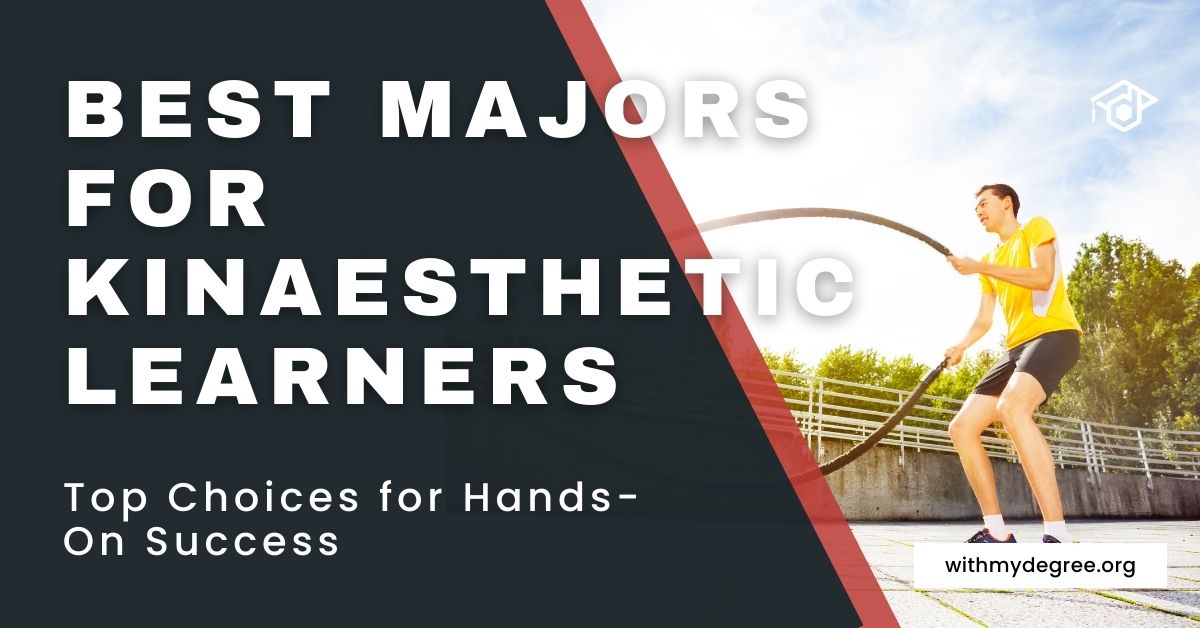If you’re a kinesthetic learner (aka kinaesthetic learner), finding the right college major can be challenging, but one great approach is to choose a field that suits your learning style.
Kinesthetic learners, also known as physical or tactile learners, thrive in environments where they can actively engage with the material and participate in hands-on learning experiences. Let’s explore some of the best majors for kinesthetic learners that cater to their strengths and preferences!

When considering which major to pursue, think about careers that involve movement, tactile sensations, and coordination. For example, you likely excel at sports, physical activities, and creative subjects, which increases the odds of finding fulfillment in careers that focus on those areas.
Understanding Kinesthetic Learners
As a kinesthetic learner, gaining insight into your unique learning style and preferences when it comes to processing and retaining information can help you select the best major to pursue.
Characteristics of Kinesthetic Learners
Kinesthetic learners often thrive in situations which incorporate physical activities and hands-on experiences. Some common attributes include:
- Excellent hand-eye coordination
- Strong motor memory
- High energy levels
- Preference for practical information over theoretical concepts
- Success in creative subjects such as art or drama
Of course, these characteristics don’t necessarily define every kinesthetic learner. Each person has their own unique learning preferences, but these provide a starting point.
Types of Learning Styles
Beyond kinesthetic learning, there are other learning styles that may influence your preferences. Here’s a brief overview:
- Visual: learn best by seeing information in the form of charts, diagrams, or other visual aids.
- Auditory: comprehend information most effectively through verbal presentations, lectures, or audio recordings.
- Reading/Writing: excel at understanding text-based material and written explanations.
- Kinesthetic: prefer hands-on experiences and bodily movement to absorb information.
Considering secondary strengths while understanding your predominant learning style can help you tailor your educational and career choices to align with your strengths.
Top Majors for Kinaesthetic Learners
Here are some top majors that cater to a hands-on learning style, broken down into different fields.
Health and Fitness
These majors involve a lot of physical practice and interaction with patients.
- Physical Therapy
- Occupational Therapy
- Kinesiology
- Nursing
Performing Arts
These majors allow you to engage with your surroundings and perform.
- Dance
- Theatre
- Circus Arts
- Music Performance
Trade and Technical Careers
Trade and technical careers often involve hands-on tasks and problem-solving. The ability to learn by doing will help you excel in these fields as you hone real-world skills.
- Automotive Technology
- Welding
- Electrical Engineering
- Carpentry
Environmental and Agricultural Fields
If you have a passion for working outdoors and connecting with nature, environmental and agricultural fields provide the opportunity to explore and physically interact with the environment around you.
- Agriculture
- Environmental Science
- Forestry
- Marine Biology
Classroom Strategies for Kinesthetic Learners
Study Tips
To help retain information you can try to:
- Use manipulatives and 3D models to visualize complex concepts.
- Walk around while studying, as movement can help you better remember the material.
Engaging in Group Activities
Participating in group activities can significantly boost your understanding and retention of concepts. Things to try:
- Include role-playing sessions, as they can help you internalize information in a more interactive manner.
- Experiment with real-world examples, as these can create stronger memory connections.
- Use hands-on learning activities with tangible objects, like clay or building blocks, for better comprehension.
Career Advantages for Kinesthetic Learners
Excellent hand-eye coordination and motor memory make you naturally skilled in careers involving physical activities and movements.
Here are a few advantages you can leverage:
- Increased information retention: The ability to learn better through movement and physical interaction leads to improved memory recall, making you a valuable team member in fast-paced physical work environments.
- High energy levels: An energetic nature helps you stay engaged and focused on tasks that require physical effort or endurance, ensuring overall productivity and performance.
- Creativity and problem-solving skills: Hands-on approaches to learning often go alongside a talent for finding creative solutions and innovations in your work.
- Flexibility and adaptability: A preference for experiential learning means that you’re often more comfortable adapting to new situations and challenges in the workplace.
Specific Careers to Consider
- Sports Coach: Train athletes in various sports, leveraging excellent motor skills and hand-eye coordination.
- Dancer or Choreographer: Express creativity in the high energy world of dance and performance arts.
- Physical Therapist: Help patients recover from injuries or manage pain, using a hands-on approach and leveraging your adaptability.
Conclusion
Pursuing a major that aligns with your natural strengths and preferences can make your educational journey more enjoyable – and successful!
Some of the best majors for you might include fields that involve hands-on learning, physical activity, and practical applications of knowledge. Finding the right major also depends on your individual interests and career goals – not just your learning style.
Research the majors you are considering carefully to determine if they align with your long-term career aspirations. Information from professionals and faculty in the fields you’re interested in can also be valuable in determining the best fit for you.
Regardless of the major you choose, remember that kinesthetic learning strategies can be applied to virtually any field. Embrace your unique learning style and seek opportunities to engage in hands-on, experiential learning whenever possible.


